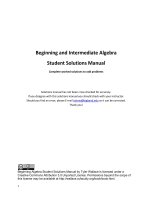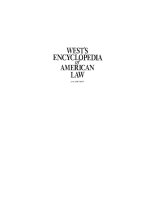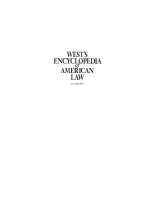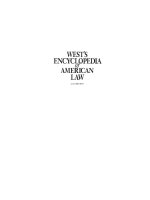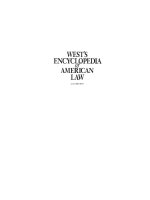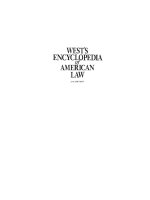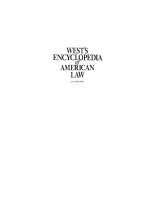logic primer - 2nd edition feb 2001
Bạn đang xem bản rút gọn của tài liệu. Xem và tải ngay bản đầy đủ của tài liệu tại đây (3.03 MB, 207 trang )
Logic
Primer
Colin Allen and Michael Hand
A
Bradford Book
The MIT Press
Cambridge, Massachusetts
London, England
O
2001 Massachusetts Institute of Technology
All rights reserved. No part of this book may be reproduced in any
form by any electronic or mechanical means (including photocopying,
recording, or information storage and retrieval) without permission in
writing from the publisher.
Printed and bound in the United States of America.
Library of Congress Cataloging-in-Publication Data
Allen, Colin.
Logic
primertcolin Allen and Michael Hand 2nd ed.
p. cm.
"A Bradford book."
Includes bibliographical references and index.
ISBN 0-262-5
1
126-6 (pbk.: alk. paper)
1. Logic. I. Hand, Michael.
11. Title
to
Lynn and Susan
Contents
Preface
Acknowledgements xix
Chapter 1 Sentential Logic
1.1 Basic Logical Notions
1.2 A Formal Language for
Sentential Logic
1.3 Translation of English to
Sentential Wffs
1.4 Primitive Rules of Proof
1.5
Sequents and Derived Rules
1.6 Theorems
Chapter 2 Truth Tables
2.1 Truth Tables for Sentences
2.2 Truth Tables for Sequents
2.3 Tautologies
2.4 Indirect Truth Tables
2.5 English Counterexamples
Chapter 3 Predicate Logic
3.1 A Formal Language for
Predicate Logic
3.2 Translation of English to
Quantified Wffs
3.3 Primitive Rules of Proof
3.4 Sequents, Theorems, and
Derived Rules of Proof
.
.
.
vlll
Contents
Chapter 4 Models
4.1 Finite Interpretations and
Expansions with One-Place
Predicates
4.2 Finite Countermodels for
Arguments with One-Place
Predicates
4.3 Finite Countermodels for
Arguments with Many-Place Predicates
4.4 Finite Countermodels for Arguments
with Identity
4.4 Infinite Countermodels
Answers to Selected Exercises
Chapter
1
Chapter 2
Chapter 3
Chapter 4
Index
Preface
To the Student
The most important thing for you to know about this book is that it is
designed to be used with a teacher. You should not expect to learn
logic from this book alone (although it will be possible if you have had
experience with formal systems or can make use of the
website at
We have deliberately reduced to
a minimum the amount of explanatory material, relying upon your
instructor to expand on the ideas. Our goal has been to produce a text
in which all of the material is important, thus saving you the expense
of a yellow marker pen. Consequently, you should never turn a page of
this book until you understand it thoroughly.
The text consists of
Definitions,
Examples,
Comments,
and Exercises.
(Exercises marked with asterisks are answered at the back of the
book.) The comments are of two sorts. Those set in full-size type
contain material we deem essential to the text. Those set in smaller
type are relatively incidental-the ideas they contain are not essential
to the flow of the book, but they provide perspective on the two logical
systems you will learn.
In this age of large classes and diminished personal contact between
students and their teachers, we hope this book promotes a rewarding
learning experience.
To the Teacher
We wrote this book because we were dissatisfied with the logic texts
now available. The authors of those texts talk too much. Students
neither need nor want page after page of explanation that require them
to turn back and forth among statements of rules, examples, and
discussion. They prefer having their teachers explain things to
them-after all, students take notes. Consequently, one of our goals
has been to produce a text of minimal chattiness, leaving to the
instructor the task of providing explanations. Only an instructor in a
given classroom can be expected to know how best to explain the
material to the students in that class, and we choose not to force upon
the instructor any particular mode of explanation.
Another reason our for dissatisfaction was that most texts contain
material that we are not interested in teaching in an introductory logic
class. Some logic texts, and indeed some very popular ones, contain
chapters on informal fallacies, theories of definition, or inductive logic,
and some contain more than one deductive apparatus. Consequently,
we found ourselves ordering texts for a single-semester course and
covering no more than half of the material in them. This book is
intended for a one-semester course in which propositional logic and
predicate logic are introduced, but no metatheory. (Any student who
has mastered the material in this book will be well prepared to take a
second course on metatheory, using Lemmon's classic,
Beginning
Logic, or even Tennant's
Natural
Logic.)
We prefer systems of natural deduction to other ways of representing
arguments, and we have adopted Lemmon's technique of explicitly
tracking assumptions on each line of a proof. We find that this
technique illuminates the relation between conclusions and premises
better than other devices for managing assumptions. Besides that, it
allows for shorter, more elegant proofs. A given assumption can be
discharged more than once, so that it need not be assumed again in
order to be discharged again. Thus, the following is possible, and there
is no need to assume
P
twice:
1 (1) P+(Q&R)
assume
2 (2)
P
assume
12
(3)
Q
&
R
from 1,2
12 (4)
Q
from 3
12
(5)
R
from 3
1 (6)
P
+
Q
from 4, discharge 2
1 (7) P+R
from 5, discharge 2
1 (8) (P
+
Q)
&
(P
+
R) from 6,7
Clearly, the notion of subderivation has no application in such a
system. The alternative approach involving subderivations allows a
given assumption to be discharged only once, so the following is
needed:
assume
assume
from 1,2
from 3
from 4, discharge 2
assume
from 1,6
(same inference as at 3!)
from 7
from
8,
discharge 6
from 5,9
The redundancy of this proof is obvious. Nonetheless, an instructor
who prefers subderivation-style proofs can use our system by changing
the rules concerning assumption sets as follows: (i) Every line has the
assumption set of the immediately preceding line, except when an
assumption is discharged. (ii) The only assumption available for
discharge at a given line is the highest-numbered assumption in the
assumption set. (iii) After an assumption has been discharged, that line
number can never again appear in a later assumption set. (In other
words, the assumption-set device becomes a stack or a first-in-last-out
memory device.)
There are a number of other differences between our system and
Lemmon's, including a different set of primitive rules of proof. What
follows is a listing of the more significant differences between our
system and Lemmon's, together with reasons we prefer our system.
Lemmon disallows vacuous discharge of assumptions. We allow
it. Thus it is correct in our system to discharge an assumption by
reductio ad absurdum when the contradiction does not depend on
that assumption. Whenever vacuous discharge occurs, one can
obtain a Lemmon-acceptable deduction by means of trivial
additions to the proof. We prefer to avoid these additions. (Note
that Lemmon's preclusion of vacuous discharge means that
accomplishing the same effect requires redundant steps of
&-
introduction and &-elimination. For instance, Lemmon requires
(a) to prove P
k
Q
+
P, while we allow (b).
(a)
1
(1)
P
assume
2 (2)
Q
assume
12 (3) Q&P from 1,2
1,2 (4)
P
from
3
1
(5)
Q+P from 4, discharge 2
(b)
1 (1) P assume
2 (2)
Q
assume
1 (3) Q+P from 1, discharge 2
Lemmon's characterization of proof entails that an argument has
been established as valid only when a proof has been given in
which the conclusion depends on all of the argument's premises.
This is needlessly restrictive, since in some valid arguments the
conclusion is in fact provable from a proper subset of the
premises. We remove this restriction, allowing a proof for a
given argument to rest its conclusion on some but not all of the
argument's premises.
We have replaced Lemmon's primitive v-Elimination rule by
what is normally known as Disjunctive Syllogism (DS). We
realize that Lemmon's rule is philosophically preferable, as it is
a pure rule; however,
DS
is so much easier to learn that
pedagogical considerations outweigh philosophical ones in this
case.
Despite the preceding point, we have kept the 3-elimination rule
used by Lemmon. Although slightly more complicated than the
more common rule of 3-Instantiation, this rule frees the student
from having to remember to instantiate existential quanti-
fications before instantiating universal quantifications. It also
frees the student from having to examine the not-yet-reached
conclusion of the argument, to determine which instantial names
are unavailable for a given application of 3-Instantiation.
Furthermore, at any point in a proof using 3-elimination, some
argument has been proven. If the proof has reached a line of the
form
m,.
. .
,n
(k)
z
then the sentence z has been established as provable from the
premise set {m,
. . .
,n}
.
(Here the right-hand ellipsis indicates
which rule was applied to yield z, and which earlier sentences it
was applied to.) This is quite useful in helping the student
understand what is going on in a proof. In a system using
3-
instantiation, however, this feature is absent: there are correct
proofs some of whose lines do not follow from previous lines,
since the rule of 3-instantiation is not a valid rule. For instance,
the following is the beginning of a proof using 3-instantiation.
assumption
1
3-instantiation
Line
2
does not follow from line
1.
This difference between 3-
elimination and 3-instantiation can be put as follows: in an 3-
elimination proof, you can stop at any time and still have a
correct proof of some argument or other, but in an 3-instantiation
proof, you cannot stop whenever you like. It seems to us that
these implications of 3-instantiation's invalidity outweigh the
additional complexity of 3-elimination. In an 3-elimination
system, not only is the
system
sound as a whole, but every rule is
individually valid; this is not true for an 3-instantiation system.
Whereas Lemmon requires that existentialization (existential
generalization) replace all tokens of the generalized name by
tokens of the bound variable, we allow existentialization to pick
up only some of the tokens of the generalized name.
We have abandoned Lemmon's distinction between proper
names and arbitrary names, which is not essential in a natural
deduction system. The conditions on quantifier rules ensure that
the instantial name is arbitrary in the appropriate sense. (We
comment on this motivation for the conditions in the text.)
In many cases, we have deliberately not used quotation marks to
indicate that an expression of the formal language is being mentioned.
In general, we use single quotes to indicate mention only when
confusion might result. (We hope no one is antagonized by this
flaunting of convention. Trained philosophers may at first find the
absence of quotes disconcerting, but we believe that we are making
things easier without leading the student astray significantly.)
We have tried to present the material in a way that reveals clearly the
systematic organization of the text. This manner of presentation makes
it especially easy for students to review the material when studying,
and to look up particular points when the need arises. Consequently,
there is little discursive prose in the text, and what seemed unavoidable
has been relegated to the
Comments.
We hope to have produced a
small text that is truly student-oriented but that still allows the
instructor a maximum of flexibility in presenting the material.
The
Second Edition
With one exception, the changes to the second edition have been
minimal. We have added a treatment of identity to chapters
3
and
4.
In
chapter
3
this required merely a slight modification to the definition of
wff, some comments on translation, and the inclusion of introduction
and elimination rules for identity. The changes made to chapter
4
are
more extensive. In the first edition we avoided overt reference to the
object
language/metalanguage distinction and had no need to introduce
into the specification of interpretations the extensions (denotations,
referents) of names, but the inclusion of identity in the language
necessitates them. To keep matters simple, when giving interpretations
for sentences that involve identity we use italicized names in the
metalanguage, and we recommend that no member of the universe of
an interpretation be given more than one metalinguistic name. This
makes it easy to specify whether or not two names of the object
language have the same extension in an interpretation, for the same
metalinguistic name will be used for names denoting the same object.
Expansions now involve the use of italicized names, so that strictly
speaking they are not wffs of the object language. This does not affect
their use in determining truth values of quantified wffs in an
interpretation, and facilitates their use in determining truth values of
wffs involving identity. (We realize that italicization is not available
for hand-written exercises, so we recommend that instructors adopt a
convention such as underlining for blackboard presentations.) The
addition of the material on identity is supplemented with new exercises
in chapters
3
and
4.
We have tried to organize the new material in such
a way that an instructor who wishes to omit it can do so easily.
In chapter
1,
a set of exercises has been inserted whose proofs do not
require
+I and RAA. That is, these proofs do not involve the
discharge of assumptions. These exercises are intended to allow
students to become comfortable with the remaining rules of proof
before they are forced to learn the more complicated mechanics of
+I
and RAA.
In chapter
3
we have waited until after the section on translations to
introduce the notions of a wff's universalization, existentialization, and
instance. This change reduces the chance of the student's confusing the
rules for constructing universally quantified wffs, where at least one
occurrence of a name must be replaced by a variable, and univers-
alization, where all occurrences of the name must be replaced.
Web Support
A
variety of interactive exercises and an automated proof checker for
the proof systems introduced in this book can be accessed at
Use of the software requires
nothing more than a basic web browser running on any kind of
computer.
Acknowledgements
We were unfortunately remiss in the first edition in failing to thank
Harry
Stanton for his encouragement to write this text. We gratefully
acknowledge the comments we have received from colleagues who
have taught from the first edition, particularly Jon Kvanvig and Chris
Menzel. A number of typographical errors were identified by an
extremely meticulous self-study reader from the Midwest whose
identity has become lost to us and whom we encourage to contact us
again (and to accept our apologies). Chris Menzel also receives credit
for his extensive (and voluntary) work on the web software. Finally,
Amy Kind deserves special thanks for her help with the
website and
for her most useful comments on the manuscript for the second edition.
Chapter
1
Sentential Logic
1.1
Basic logical notions
argument,
Definition.
An
ARGUMENT
is a pair of things:
premises,
a set of sentences, the
PREMISES
conclusion
a sentence, the
CONCLUSION.
Comment.
All arguments have conclusions, but not all
arguments have premises: the set of premises can be
the empty set! Later we shall examine this idea in
some detail.
Comment.
If the sentences involved belong to English (or any other
natural language), we need to specify that the premises and the
conclusion are sentences that can be true or false. That is, the
premises and the conclusion must all be declarative (or indicative)
sentences such as 'The cat is on the
mat' or
'I
am here', and not
sentences such as 'Is the cat on the mat?' (interrogative) or 'Come
here!' (imperative). We are going to construct some formal
languages in which every sentence is either true or false. Thus this
qualification is not present in the definition above.
validity
Definition.
An argument is
VALID
if and only if it is
necessary that
ifall its premises are true, its conclusion
is true.
Comment.
The intuitive idea captured by this defi-
nition is this: If it is possible for the conclusion of an
argument to be false when its premises are all true,
then the argument is not reliable (that is, it is invalid).
If true premises guarantee a true conclusion then the
argument is valid.
Alternate formulation of the definition.
An argument is
VALID
if and only if it is impossible for all the
premises to be true while the conclusion is false.
entailment
Definition.
When an argument is valid we say that its
premises
ENTAIL
its conclusion.
soundness
Definition.
An argument is
SOUND
if and only if it is
valid and all its premises are true.
Comment.
It follows that all sound arguments have
true conclusions.
Comment.
An argument may be unsound in either of
two ways: it is invalid, or it has one or more false
premises.
Comment.
The rest of this book is concerned with validity rather
than soundness.
Exercise
1.1
Indicate whether each of the following sentences is
True or False.
i* Every premise of a valid argument is true.
ii*
Every invalid argument has a false conclusion.
iii" Every valid argument has exactly two premises.
iv* Some valid arguments have false conclusions.
v* Some valid arguments have a false conclusion despite
having premises that are all true.
vi
*
vii*
viii*
ix
*
x
*
A
sound argument cannot have a false conclusion.
Some sound arguments are invalid.
Some unsound arguments have true premises.
Premises of sound arguments entail their conclusions.
If
an
argument has true premises and a true conclusion
then it is sound.
formal
language
vocabulary
sentence
letter
sentence
variable
A
Formal Language for Sentential Logic
Comment.
To represent similarities among arguments
of a natural language, logicians introduce formal
languages. The first formal language we will introduce
is the language of sentential logic (also known as
propositional logic). In chapter
3
we introduce a more
sophisticated language: that of predicate logic.
Definition.
The
VOCABULARY OF SENTENTIAL
LOGIC
consists of
SENTENCE LETTERS,
CONNECTIVES,
and
PARENTHESES.
Definition. A
SENTENCE LETTER
is any symbol
from the following list:
A, .
,
z, Ao,
,
zo, Al,
,zl, .
,
Comment.
By the use of subscripts we make available
an infinite number of sentence letters. These sentence
letters are also sometimes called
SENTENCE VARI-
ABLES,
because we use them to stand for sentences
of natural languages.
connectives
Definition.
The
SENTENTIAL CONNECTIVES
(often just called
CONNECTIVES)
are the members
of the following list:
-,
&,
v,
+,
e.
Comment.
The sentential connectives correspond to
various words in natural languages that serve to
connect declarative sentences.
tilde
-
The
TILDE
corresponds to the English 'It is not the
case that7. (In this case the use of the term 'connective'
is odd, since only one declarative sentence is negated
at a time.)
ampersand
&
The
AMPERSAND
corresponds to the English 'Both
. . .
and
. .
.'.
wedge
v
The
WEDGE
corresponds to the English 'Either
. . .
or
. .
.'
in its inclusive sense.
arrow
+
The
ARROW
corresponds to the English 'If
. . .
then
2
double-
H
The
DOUBLE-ARROW
corresponds to the English
arrow
'if and only if'.
Comment.
Natural languages typically provide more than one way
to express a given connection between sentences. For instance, the
sentence 'John is dancing but Mary is sitting down' expresses the
same logical relationship as 'John is dancing and Mary is sitting
down'. The issue of translation from English to the formal
language is taken up in section
1.3.
)
and
(
The right and left parentheses are used as punctuation
marks for the language.
expression
Definition.
An
EXPRESSION
of sentential logic is
any sequence of sentence letters, sentential connec-
tives, or left and right parentheses.
Examples.
(P
+
Q)
is an expression of sentential logic.
)PQ+-
is also an expression of sentential logic.
(3
+
4)
is not an expression of sentential logic.
metavariable
Definition.
Greek letters such as
(I
and
y~
are used as
METAVARIABLES.
They are not themselves parts of
the language of sentential
logic,
but they stand for
expressions of the language.
Comment.
(@
+
y~)
is not an expression of sentential
logic, but it may
be
used to represent an expression of
sentential logic.
6
Chapter
1
well-formed
Definition.
A
WELL- FORMED FORMULA (WFF)
formula
of sentential logic is any expression that accords with
the following seven rules:
(1)
A sentence letter standing alone is a wff.
atomic
[Definition.
The sentence letters are the
ATOMIC
sentence SENTENCES
of the language of sentential logic.]
(2)
If
@
is a wff, then the expression denoted by
-@
is
also a wff.
negation
[Definition.
A
wff of this form is known as a
NEGA-
TION,
and
-@
is known as the
NEGATION OF
@.I
(3)
If
@
and
v
are both wffs, then the expression
denoted by
(@
&
v) is a wff.
conjunction
[D@nition.
A
wff of this form is known as a
CON-
JUNCTION.
@
and
y~
are known as the left and right
CONJUNCTS,
respectively.]
(4)
If
@
and
v
are both wffs, then the expression
denoted by
(@
v
v) is a wff.
disjunction
[Definition.
A
wff of this form is known as a
DIS-
JUNCTION.
4
and
y~
are the left and right
DISJUNCTS,
respectively.]
(5)
If
@
and
y~
are both wffs, then the expression
denoted by
(@
+
v) is a wff.
conditional,
[Definition.
A
wff of this form is known as a
CONDI-
antecedent, TIONAL.
The wff
@
is known as the
ANTECEDENT
consequent
of the conditional. The wff
v
is known as the
CONSEQUENT
of the conditional.]
(6)
If
@
and
v
are both wffs, then the expression
denoted by
(@
w
v)
is a wff.
biconditional
[Definition. A
wff of this form is known as a
BICONDITIONAL.
It is also sometimes known as an
EQUIVALENCE.]
(7)
Nothing else is a
wff.
binary
Definition.
&,
v,
+,
and
H
are
BINARY CONNEC-
and unary TIVES,
since they connect two wffs together.
-
is a
connectives UNARY CONNECTIVE,
since it attaches to a single
wff.
sentence
Definition.
A
SENTENCE
of the formal language is a
wff that is not part of a larger wff.
denial
Definition.
The
DENIAL
of a wff
@
that is not a
negation is
-@.
A
negation,
-@,
has two
DENIALS:
@
and
@.
Example.
-(P
+
Q) has one negation: (P
+
Q)
It has two denials: (P
+
Q) and (P
+
Q).
(P
+
Q) has just one denial: its negation, -(P
+
Q).
Comment.
The reason for introducing the ideas of a sentence and a
denial will be apparent when the rules of proof are introduced in
section
1.4.
Exercise
1.2.1
Which of the following expressions are wffs? If an
expression is a wff, say whether it is an atomic
sentence, a conditional, a conjunction, a disjunction, a
negation, or a biconditional. For the binary connec-
tives, identify the component wffs (antecedent, con-
sequent, conjuncts, disjuncts, etc.).
i*
ii*
iii*
iv*
v*
vi
*
vii*
viii*
ix
*
X*
xi*
xii*
xiii*
xiv
*
xv*
A
(A
(A)
(A
+
B)
(A
+
(
(A
+
(B
+
C))
((P
&
Q)
+
R)
((A
&
B)
v
(C
+
(D
-
GI))
-(A
+
B)
-(P
+
Q)
v
-(Q
&
R)
-(A)
(-A)
+
B
(-(P
&
P)
&
(P
-
(Q
v
-Q)))
(-((B
v
P)
&
C)
e
((D
v
-G)
+
H))
(-(Q
v
-(B))
v
(E
-
(D
v
X)))
Chapter
I
9
parenthesis-
Comment.
For ease of reading, it is often convenient to
dropping
drop parentheses from wffs, so long as no ambiguity
conventions
results. If a sentence is surrounded by parentheses then
these may be dropped.
Example.
P
+
Q
will be read as shorthand for
(P
+
Q).
Comment.
Where parentheses are embedded within
sentences we must be careful if we are to omit any
parentheses. For example, the expression
P
&
Q
+
R
is potentially ambiguous between
((P
&
Q)
+
R)
and
(P
&
(Q
+
R)).
To resolve such ambiguities, we adopt
the following convention:
-
binds more strongly than
all the other connectives;
&
and
v
bind component
expressions more strongly than
+,
which in turn binds
its components more strongly than
w.
Examples.
-P
&
Q
+
R
is read as
((-P
&
Q)
+
R).
P
+
Q
e
Ris read as
((P
+
Q) HR).
P
v
Q
&
R
is not allowed, as it is ambiguous between
(P
v
(Q
&
R))
and
((P
v
Q)
&
R).
P
+
Q
+
R
is not allowed, as it is ambiguous between
(P
+
(Q
+
R))
and
((P
+
Q)
+
R).
Comment.
The expressions admitted by these paren-
thesis-dropping conventions are not themselves
well-
formed formulas of sentential logic.

